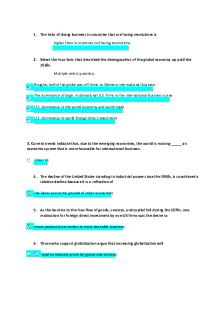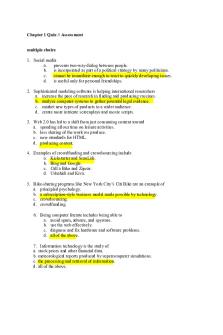Urinalysis- Chapter 1 - practice quiz PDF

| Title | Urinalysis- Chapter 1 - practice quiz |
|---|---|
| Course | Medical Technology |
| Institution | Far Eastern University |
| Pages | 4 |
| File Size | 52.1 KB |
| File Type | |
| Total Downloads | 25 |
| Total Views | 154 |
Summary
practice quiz...
Description
CHAPTER 1: SAFETY AND QUALITY ASSESSMENT STUDY QUESTIONS 1. In the urinalysis laboratory, the primary source in the chain of infection would be: a. Patients b. Needlesticks c. Specimens d. Biohazardous waste
2. The best way to break the chain of infection is: a. Hand sanitizing b. Personal protective equipment c. Aerosol prevention d. decontamination
3. The current routine infection control policy developed by CDC and followed in all health-care settings is: a. Universal Precautions b. Isolation Precautions c. Blood & Body Fluid Precautions d. Standard Precautions
4. An employee who is accidentally exposed to a possible blood-borne pathogen should immediately: a. report to a supervision b. flush the area with water c. clean the area with disinfectant d. receive HIV prophylaxis
5. Personnel in the urinalysis laboratory should wear lab coats that: a. do not have buttons b. are fluid-resistant c. have short sleeves d. have full-length zippers
6. All of the following should be discarded in biohazardous waste containers EXCEPT: a. urine specimen containers b. towels used for decontamination c. disposable lab coats d. blood collection tubes
7. An employer who fails to provide sufficient gloves for the employees may be fined by the: a. CDC b. NFPA c. OSHA d. FDA
8. An acceptable disinfectant for blood and body fluid decontamination it: a. sodium hydroxide b. antimicrobial soap c. hydrogen peroxide d. sodium hypochlorite
9. Proper handwashing includes all of the following EXCEPT: a. using warm water b. rubbing to create a lather c. rinsing hands in a downward position d. turning on the water with a paper towel
10. Centrifuging an uncapped specimen may produce a biological hazard in the form of: a. vectors b. sharps contamination c. aerosols d. specimen contamination
11. An employee who accidentally spills acid on his arm should immediately: a. neutralize the acid with a base b. hold the arm under running water for 15 minutes c. consult MSDS d. wrap the arm in gauze and go to the emergency room
12. When combining acid and water, ensure that: a. acid is added to water b. water is added to acid c. they are added simultaneously d. water is slowly added to acid
13. An employee can learn the carcinogenic potential of potassium chloride by consulting the: a. chemical hygiene plan b. Material safety data sheets c. OSHA standards d. urinalysis procedure manual
14. Employees should not work with radioisotopes if they are: a. wearing contact lenses b. allergic to iodine c. sensitive to latex d. pregnant
15. All of the following are safe to do when removing the source of an electric shock EXCEPT: a. pulling the person away form the instrument b. turning off the circuit breaker c. using a glass container to move the
instrument d. unplugging the instrument
16. The acronym PASS refers to: a. presence of vital chemicals b. operation of a fire extinguisher c. labeling of hazardous material d. presence of radioactive substances
17. The system used by firefighters when a fire occurs in the laboratory is: a. MSDS b. RACE c. NFPA d. PASS
18. A class ABC fire extinguisher contains: a. sand b. water c. dry chemicals d. acid
19. The first thing to do when a fire is discovered is to: a. rescue the persons in danger b. activate the alarm system c. close doors to other areas d. extinguish the fire if possible
20. If a red rash is observed after removing gloves, the employee: a. may be washing her hands too often b. may have developed a latex allergy c. should apply cortisone cream d. should not rub hands so vigorously
21. Pipetting by mouth is: a. acceptable for urine but not semen b. not acceptable without proper
training c. acceptable for reagents but not specimens d. not acceptable in the lab
22. The NPFA classification symbol contains information on all of the following EXCEPT: a. fire hazards b. biohazards c. reactivity d. health hazards
23. The classification of a fire that can be extinguished with water is: a. Class A b. Class B c. Class C d. Class D
24. Employers are required to provide free immunization for: a. HIV b. HTLA-1 c. HBV d. HCV
25. A possible physical hazard in the hospital is: a. wearing closed toed shoes b. not wearing jewelry c. having short hair d. running to answer the phone
26. Quality assessment refers to: a. analysis of testing controls b. increased productivity c. precise control results d. quality of specimens and patient care
27. During laboratory accreditation inspections, procedure manuals are examined for the presence of: a. critical values b. procedure references c. procedure for specimen preservation d. all of the above
28. As supervisor of the urinalysis laboratory, you have just adopted a new procedure. You should: a. put the package insert in the procedure manual b. put a complete, referenced procedure in the manual c. notify the microbiology department d. put a cost analysis study in the procedure manual
29. Indicate whether each of the following would be considered 1) preexamination, 2) examination, or 3) postexamination factor: _____ reagent expiration date _____ rejecting a contaminated specimen _____ constructing a Levy-Jennings chart _____ telephoning a positive Clinitest result on a newborn _____ calibrating the centrifuge _____ collecting a timed urine specimen
30. The testing of sample from an outside agency and the comparison of results with participating labs is called: a. External QC b. Electronic QC
c. Internal QC d. Proficiency testing
31. A color change that indicates that a sufficient amount of patient's specimen or reagent is added correctly to the test system would be an example of: a. External QC b. Equivalent QC c. Internal QC d. Proficiency testing
32. What steps are taken when the results of reagent strip QC are outside of the stated confidence limits? a. check the expiration date of the reagent strip b. run a new control c. open a new reagent strips container d. all of the above
33. When a new bottle of QC material is opened, what information is placed on the label? a. the supervisor's initials b. the lot number c. the date and lab worker's initials c. the time the bottle was opened
34. When a control is run, what information is documented? a. the lot number b. expiration date of the control c. the test results d. all of the above...
Similar Free PDFs

Chapter 1 - quiz practice
- 5 Pages

Quiz-5 - Urinalysis
- 3 Pages

Quiz-2 - Urinalysis
- 7 Pages

MGT2381 Chapter 1 Practice Quiz
- 6 Pages

Chapter 24 quiz - Practice Quiz
- 3 Pages

Chapter 7 Practice Quiz
- 19 Pages

Practice Quiz Chapter 3
- 6 Pages

Chapter 3 - quiz practice
- 5 Pages

Chapter 48 Practice Quiz
- 3 Pages

Sample Quiz #1 - Practice Quiz
- 2 Pages

Patho Practice Quiz 1
- 5 Pages

HW 1 - Quiz Practice
- 7 Pages

Practice Quiz 1
- 2 Pages
Popular Institutions
- Tinajero National High School - Annex
- Politeknik Caltex Riau
- Yokohama City University
- SGT University
- University of Al-Qadisiyah
- Divine Word College of Vigan
- Techniek College Rotterdam
- Universidade de Santiago
- Universiti Teknologi MARA Cawangan Johor Kampus Pasir Gudang
- Poltekkes Kemenkes Yogyakarta
- Baguio City National High School
- Colegio san marcos
- preparatoria uno
- Centro de Bachillerato Tecnológico Industrial y de Servicios No. 107
- Dalian Maritime University
- Quang Trung Secondary School
- Colegio Tecnológico en Informática
- Corporación Regional de Educación Superior
- Grupo CEDVA
- Dar Al Uloom University
- Centro de Estudios Preuniversitarios de la Universidad Nacional de Ingeniería
- 上智大学
- Aakash International School, Nuna Majara
- San Felipe Neri Catholic School
- Kang Chiao International School - New Taipei City
- Misamis Occidental National High School
- Institución Educativa Escuela Normal Juan Ladrilleros
- Kolehiyo ng Pantukan
- Batanes State College
- Instituto Continental
- Sekolah Menengah Kejuruan Kesehatan Kaltara (Tarakan)
- Colegio de La Inmaculada Concepcion - Cebu


